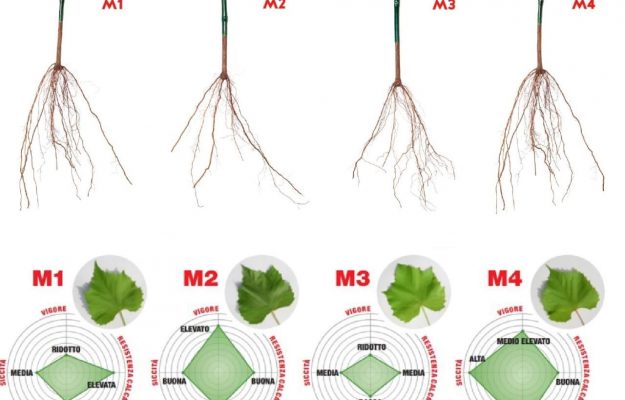Professor Attilio Scienza commented on the monitoring results carried out by the Faculty of Agriculture of the University of Milan and Winegraft, “100% of the vineyards planted on “M rootstocks” are dealing brilliantly with his extremely dry summer and showing excellent quality and quantity results”. Winegraft is the University of Milan’s start-up founded in 2014 by some of the leading Italian wineries, such as Ferrari, Zonin, Banfi Società Agricola, Armani Albino, Cantina Due Palme, Claudio Quarta Vignaiolo, Bertani Domains, Nettuno Castellare, and Cantine Settesoli to sustain the development of research on the new generation of rootstocks. Hundreds of vineyards scattered across various areas from Northern to Southern Italy were planted with vines, where the extraordinary resistance of the “M” rootstock (specifically, the M2 and M4) to water stress and the extreme summer temperatures is changing Italian agriculture and viticulture. The results are clear and show that the photosynthetic activity of M rootstocks is 35% and 20% higher than the more common rootstocks, which means that there is a significant saving in water resources, and therefore, a plus in terms of economic and environmental sustainability. The goal is now to reach 5 million cuttings per year by 2025.
“The companies that planted vines with these new generation rootstocks will see the difference in the next harvest”, Lucio Brancadoro, professor and researcher at the Faculty of Milan, emphasized, “because, unlike the others, the vineyards that use “M rootstocks” show better resilience to water stress conditions, thanks to their greater water using efficiency. They are thus able to sustain, even in these extreme climatic conditions, a favorable photosynthetic activity of the plant, which translates into grape development, avoiding or at least limiting the production and quality losses that have been reported in numerous Italian vineyards”.
The Milan research team has been carrying out controls for over 15 years in some of the main wine-growing areas of Lombardy, Tuscany and Sicily on the “M rootstocks” planted with different vines (including Chardonnay, Sangiovese, and Cabernet Sauvignon and Nero d ‘Avola). The monitoring controls have confirmed, this year as well, that “these rootstocks”, Lucio Brancadoro, Professor and researcher at the Faculty of Milan, continued, “besides possessing characteristics such as a wide geotropic angle or high density of the root systems, which together with others, allow good, if not even better water catchment from the soil, compared to most of the rootstocks used. They also show the physiology of water resource usage that is completely different from traditional rootstocks considered tolerant to water stress. The latter have a conservative attitude towards water, inducing rapid and early closure of the stomata to conserve the water inside them. However, this leads to interrupting the activity of the plant, which is what is happening in most Italian vineyards. The M rootstocks, on the other hand, teach the vine to use water carefully, almost sparingly, making it possible to not interrupt photosynthetic activity, even in high-stress conditions. We are talking about M4 and M2, specifically, which are the most efficient, and which to date show, respectively, in Franciacorta and Chianti Classico that photosynthetic activity is more than 35% and 20%, compared to the most common rootstocks. Furthermore, the M1 and M3, although more suitable for cool climates, are giving better than satisfactory results”.
The performance of the M rootstocks, following numerous experiments in various vineyard areas around Italy, “has now begun to convince a wide range of winemakers”, Eugenio Sartori, DG of Vivai Cooperativi Rauscedo, added, “who have been able to directly verify the considerable savings in water consumption, and consequently, in economic and environmental sustainability the “M” rootstocks have achieved, together with a high resistance to thermal stress, which has become indispensable for managing the vineyard in climate change situations like the current one”. The numbers of Vivai Cooperativi Rauscedo (VCR) confirm the success of the “M”. From 2015 to date, production has increased 80 times, for a total of 4.8 million cuttings produced overall. “In the past three years alone, we have multiplied our production effort three times over, reaching 1.7 million plants ready for the next 2022/2023 harvest”, Eugenio Sartori concluded, “but our goal is to reach 5 million cuttings per year in 2025 able to sustain 1,600 hectares of new plants”.
“Therefore, we will be able to cover almost 25% of the dowry of new vines per year the authorization system allows, as well as strengthen resilience in the wine system”, Marcello Lunelli, president of Winegraft, commented. “Climate Change, and pushing towards sustainability with renewed attention to the water footprint are breaking down the cultural resistance of winemakers towards new rootstocks. It is now clear that we must respond to the recurring water crises, such as this year’s that could compromise the 2022 harvest in its final stages in many areas of Italy, with efficiency and savings”, Marcello Lunelli concluded, “and, when it comes to water in agriculture, the first solution is efficient water management of the plant. And, in the vineyard, this means M Rootstocks, the latest generation of root systems resulting from long-term research activity, carried out by the University of Milan, together with the support of Winegraft, which provide up to 40% in water consumption savings”.
Copyright © 2000/2025
Contatti: info@winenews.it
Seguici anche su Twitter: @WineNewsIt
Seguici anche su Facebook: @winenewsit
Questo articolo è tratto dall'archivio di WineNews - Tutti i diritti riservati - Copyright © 2000/2025








































































































































































































